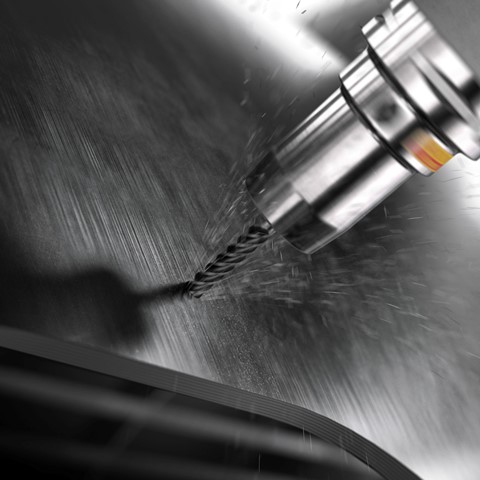
When drilling holes in most aerospace components, manufacturers have three chances of getting the hole correct — after which, it will be impossible to rework the hole within the required design specifications. If just one hole misses those three chances, by diameter, surface finish or delamination, the entire component will need to be scrapped. Given the enormous value of airplane components, holemaking is a risky business. That applies especially when drilling composite materials, which place new demands on machining.
Holemaking has emerged as one of the most common machining processes when working with composites. Machining composite materials — that combine two or more materials with different physical and chemical properties — involves cutting, or fracturing, of the fiber part of the material. If this is done incorrectly then layers of the composite material peel away from where they belong. This is known a delamination which, according to Sandvik Coromant’s customers, is the most limiting factor in their production.
Delamination effects hole quality and repeatability, the quality and integrity of the final product and manufacturers’ profits. I say integrity, because better hole quality is vital for preventing component failure and is very much determined by the manufacturing processes that are used for machining or finishing the holes.
The amount of heat generated during composite machining also becomes significant. The material’s poor heat conduction and the absence of chips pose risk to the resin that holds the material’s fibers together. In other words, the machining of composites illuminates weakness in the machining process that might otherwise be overlooked.
These weaknesses are emphasized by the growing range, and unpredictability, of composite materials available on the market. This makes competitive machining a challenge.
Why am I mentioning this now? Well, hole quality is now arguably more important than ever in the era of COVID-19. According to research by Euromonitor International, around 50% of companies plan to reshape their digital strategies. One-third of respondents in Euromonitor’s Voice of the Industry survey 2020 said they will accelerate investments into automation tools — so, those holes need to be made correctly in unmanned lights-out scenarios.
Therefore, manufacturers need to keep rethinking how they go about drilling composites.
Predictable wear
We’ve established that hole surface integrity is a real concern for aerospace manufacturers. But, what role can tools play in addressing these concerns — and how can a better drill benefit an automation strategy?
First, let’s look at the ideal that manufacturers are striving for. They want holes that are of good quality, consistent and repeatable. Of course, any tool will wear out eventually, but this wear must be consistent and predictable from tool-to-tool.
I can’t emphasize enough the importance for predictable wear. Usually, a CNC will be programmed to pull out the tool at the point of failure. So, if the lifecycle of the drill is not consistent then, in a terrible-but-realistic scenario, you could cut the tool life of most of the products you buy by 50%. When Sandvik Coromant supplies a drill to its customers, we must be able to guarantee that the drill will last for a predictable number of minutes, whatever the circumstances — every time!

Better by design
That’s why Sandvik Coromant developed its CoroDrill 863-O high performance drill for composites, including carbon fiber reinforced (CFRP) and glass fiber reinforced (GFRP) materials. The drill has been designed with a focus on industries that make wide use of composite materials and demand more feet of material drilled per tool — like the aerospace industry, which uses composite materials for manufacturing aircraft frames and other parts.
To develop the CD863-O tool, the O represent composite only applications, the first thing we did was apply it to the material in aerospace that is most prone to delamination. Specifically, unidirectional laminate with no peel-ply or woven back, which is most commonly used in aerospace wings and fuselage. We digitally mapped the delamination to determine exactly how much delamination we experienced over the life of the tools.
The computer system was set with very tight tolerances, meaning the amount of delamination we’d accept in any given hole. From the resulting data, we could optimize essential aspects of the drill’s design, like the angle of the helix — or the spiral groove around the drill. A higher helix benefits chip evacuation, so can help reduce delamination on the exit side. In contrast, too high a helix can separate layers in the composite material on the entry side. Either way, this can result in layers or fibers overhanging the hole.
Other key features of the CD863-O are its profile and its grade. Composite materials are not homogenous, and the appearance of any new material on a production run presents unique challenges; its own thickness, type of composition and so on. The CD863-O’s superior features are designed to tackle any material.
Then there is the issue of grade. Carbide drills are well suited to machining aerospace components because carbide strengthens the tool through the cutting geometry and the shank. This optimizes the cutting action and maximizes clearance and material evacuation. However, because of the abrasive nature of composites, carbide also wears quickly. This is problematic, especially in automated production setups.
To overcome this, the CD863-O has Chemical Vapor Deposition (CVD) technology. CVD is a very hard tool material that is ideal for machining composites and stacked materials. Applying CVD layers across the entire cutting edge can give much longer tool life and, due to CVD’s low coefficient of friction and high conductivity of heat, the tool’s cutting edges are less susceptible to built-up edge (BUE). Since CVD remains sharp, this removes heat and has low friction and minimizes the tendency for problems in holes.
So, the CVD grade is preferable where hole count is high and higher productivity is required.
Well-equipped robots and field testing
The wider CoroDrill 863 family is already benefitting manufacturers’ automated production setups — both in CNCs and robots on the production line. Because it’s available in carbide, polycrystalline diamond (PCD) and CVD coated options, the drill can be left to machine all kinds of difficult material types — composites, aluminum, titanium, heat resistant super alloys and stainless steels — in unmanned or lights-out processes.
Once out of the laboratory, the performance of the CD863-O was put to the test by drilling holes into a carbon fiber workpiece. Carbon fiber is a popular choice of material in aerospace applications as engineers look to make lighter aircraft structures, thanks to the material’s superior strength-to-weight ratio.
A component with an average thickness of 0.25 inches was subjected to two sets of drilling with a CD863-O geometry, which uses our own variant of CVD called O1AD for improved wear resistance in composite materials. First, the workpiece was machined with a 863-O drill with a cutting diameters (DC) of 6.37 mm (0.25 inches). Secondly, with a DCs of 4.85 mm (0.191 inches).
In both sets and with all tools, the CD863-O showed excellent results. 400 holes were drilled in the carbon fiber at a DC of 6.37 mm (0.25 inches) and 560 holes at 4.85 mm (0.191 inches), even still at an early stage in their tool life the results matched laboratory testing remarkably well.
Using Sandvik Coromant’s Capacity Data Management system, which is a system for predicting and forecasting tool life for our customers, we accurately estimated a safe tool life. Overall, this demonstrates the product’s capabilities in providing excellent tool life, reduced tool changes, and repeatable and reliable performance in composite machining. Importantly, all of the holes had low levels of delamination upon entry, or exit, throughout both test runs.
So, it’s clear that dedicated cutting tools are critical to achieving success in holemaking — especially in components made from composite or stacked materials. Tools like the CD863-O drill can also play a crucial role in helping companies fully-automate their processes, even when machining tough composite materials.
Contact Details
Related Glossary Terms
- abrasive
abrasive
Substance used for grinding, honing, lapping, superfinishing and polishing. Examples include garnet, emery, corundum, silicon carbide, cubic boron nitride and diamond in various grit sizes.
- alloys
alloys
Substances having metallic properties and being composed of two or more chemical elements of which at least one is a metal.
- built-up edge ( BUE)
built-up edge ( BUE)
1. Permanently damaging a metal by heating to cause either incipient melting or intergranular oxidation. 2. In grinding, getting the workpiece hot enough to cause discoloration or to change the microstructure by tempering or hardening.
- chemical vapor deposition ( CVD)
chemical vapor deposition ( CVD)
High-temperature (1,000° C or higher), atmosphere-controlled process in which a chemical reaction is induced for the purpose of depositing a coating 2µm to 12µm thick on a tool’s surface. See coated tools; PVD, physical vapor deposition.
- chemical vapor deposition ( CVD)2
chemical vapor deposition ( CVD)
High-temperature (1,000° C or higher), atmosphere-controlled process in which a chemical reaction is induced for the purpose of depositing a coating 2µm to 12µm thick on a tool’s surface. See coated tools; PVD, physical vapor deposition.
- clearance
clearance
Space provided behind a tool’s land or relief to prevent rubbing and subsequent premature deterioration of the tool. See land; relief.
- composites
composites
Materials composed of different elements, with one element normally embedded in another, held together by a compatible binder.
- computer numerical control ( CNC)
computer numerical control ( CNC)
Microprocessor-based controller dedicated to a machine tool that permits the creation or modification of parts. Programmed numerical control activates the machine’s servos and spindle drives and controls the various machining operations. See DNC, direct numerical control; NC, numerical control.
- polycrystalline diamond ( PCD)
polycrystalline diamond ( PCD)
Cutting tool material consisting of natural or synthetic diamond crystals bonded together under high pressure at elevated temperatures. PCD is available as a tip brazed to a carbide insert carrier. Used for machining nonferrous alloys and nonmetallic materials at high cutting speeds.
- shank
shank
Main body of a tool; the portion of a drill or similar end-held tool that fits into a collet, chuck or similar mounting device.
- stainless steels
stainless steels
Stainless steels possess high strength, heat resistance, excellent workability and erosion resistance. Four general classes have been developed to cover a range of mechanical and physical properties for particular applications. The four classes are: the austenitic types of the chromium-nickel-manganese 200 series and the chromium-nickel 300 series; the martensitic types of the chromium, hardenable 400 series; the chromium, nonhardenable 400-series ferritic types; and the precipitation-hardening type of chromium-nickel alloys with additional elements that are hardenable by solution treating and aging.
- wear resistance
wear resistance
Ability of the tool to withstand stresses that cause it to wear during cutting; an attribute linked to alloy composition, base material, thermal conditions, type of tooling and operation and other variables.

